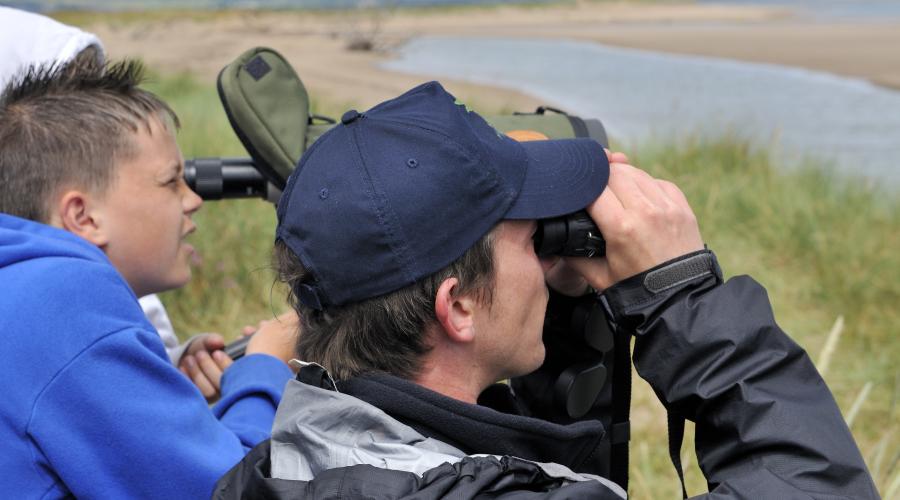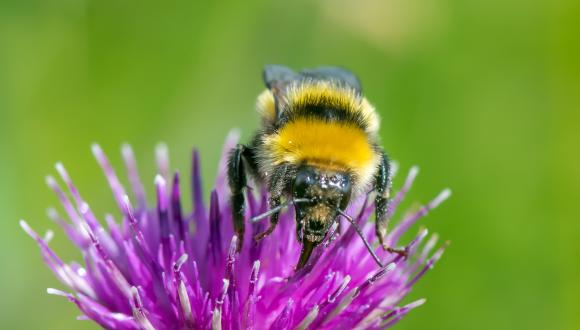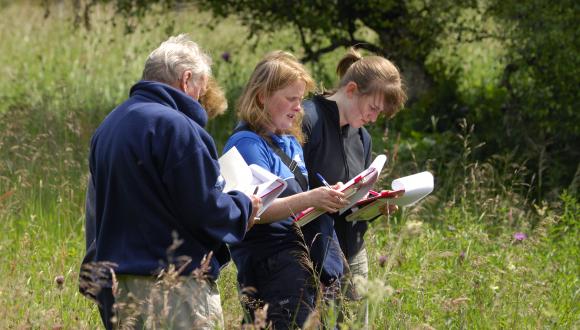
Citizen Science for biodiversity
Taking part in Citizen Science is a really useful and fun way of helping the environment and expanding our scientific knowledge.
Why not try to travel by foot or cycle?
A big thank you to all Citizen Scientists!
Citizen science is the driving force behind conservation work in Scotland, and it’s integral to the work that NatureScot does. Without the immense hard work of Scotland’s dedicated citizen scientists, we would not have such a rich understanding of the changes in our land and sea. So, we want to say thank you. Thank you to all the volunteers who have dedicated their time and energy to help build our understanding of biodiversity and nature. Thank you for your contribution to research, reporting, and policy. Thank you for helping Scotland realise a nature-rich future.
While we could only mention a few of the vast number of organisations, groups, and individuals we work with - this thank you is for everyone!
To mark the end of the 2020 Biodiversity Challenge, our Chief Executive Francesca Osowska, along with staff from across NatureScot, wanted to say thank you and celebrate your contributions to protecting and enhancing nature in Scotland.
Why Citizen Science?
Taking part in Citizen Science is a really useful way of helping the environment and expanding our scientific knowledge. Information gathered by Citizen Scientists is vital to scientists across Scotland in understanding how the environment is doing and where more action is needed. By getting involved you really can make a difference!
There are different surveys to take part in depending on how much time you have to spend, and many of them don't require any previous knowledge. Check out these great resources spanning a range of areas, habitats and species.
Surveys
Birds
BTO Garden BirdWatch. A weekly wildlife survey where participants contribute sightings of species they have seen in their gardens. Through this we are able to monitor the fortune of birds, mammals, reptiles, amphibians and invertebrates in gardens contributing to our understanding of urban wildlife.
If you are lucky enough to have birds nesting in your garden this spring, please take part in BTO’s Nesting Neighbours.
RSPB Breakfast Birdwatch. The daily Breakfast Birdwatch takes place between 8-9am - helping people to share their wildlife encounters and provide ideas for things you can do for wildlife close to home. Include #BreakfastBirdwatch when sharing updates, photos, videos, questions and comments.
Swift Surveyors in Tayside. Sightings of flying swifts and knowledge of actual nest sites. This task can be undertaken from your own garden or front door - counting the number of swifts that fly over (and repeating the survey as often as you wish between May and August). Not sure of the difference between a swift, house marten or swallow? Download the survey form and ID chart.
Amphibians and Reptiles
Recordpool. The Record Pool collects data on reptiles and amphibians in the UK and makes them available, locally and nationally, for conservation purposes. The site welcomes garden records, as well as observations made whilst out exercising locally.
Garden Dragon Watch. Gardens can provide important habitats for reptiles and amphibians. The Amphibian and Reptile Conservation's survey of these recommends spending a few minutes carefully looking in your garden and then telling them about what you find by filling in a form on your device.
Invertebrates
Cellar Spider Survey. There are only three Cellar Spider species in Britain, of which two are mostly found in homes (and not just in cellars!), making them ideal for a national survey. They are relatively easy to tell apart and often easy to find. Download details of the survey.
RHS Cellar Slug Survey. Our survey asks members of the public to submit records of Yellow Cellar Slug and Green Cellar Slug in UK gardens, along with information about your garden so we can establish any links between habitat features and where these species occur.
Beewatch is a collaborative research project between Aberdeen University and the Bumblebee Conservation Trust. This online tool uses technology to assist participants in improving their bumblebee identification skills and provides computer-generated feedback. It also uses crowd sourcing by allowing competent users to help in identifying other users’ bumblebee photographs.
The UK Pollinator Monitoring Scheme (FIT Count) aims to establish how insect pollinator populations are changing across Great Britain. Carry out a FIT Count (Flower-Insect Timed Count) by taking ten minutes to sit and collect data on the total number of insects that visit a particular flower, ideally chosen from our list of 14 target flowers in your garden during warm, dry weather any time from April to September.
Garden Butterfly Survey. Record the butterflies that visit your garden over the course of a year. Create a free account, submit your sightings and help Butterfly Conservation learn more about how butterflies are faring in UK gardens.
Garden Moth Scheme. Sign up and add to the national knowledge of moth populations.
The UK Ladybird Survey aims to encourage the recording of all species of ladybird found within the UK – including the invasive harlequin ladybird. On their great website, you will find lots of information to help you find and identify species, and online forms so that you can record your observations.
Bee-fly Watch 2020. Join in with Bee-fly Watch 2020. Bee-fly Watch is now into its fifth year. These distinctive furry flies are usually on the wing from March to June, often hovering over flowers and using their long 'nose' (proboscis) to feed on nectar. Once again we are asking people to look out for bee-flies and add your records.
Plants
BSBI activities to enjoy while under lockdown, including the Garden Wildflower Hunt. A citizen science project set up by the Botanical Society of Britain & Ireland with two aims: to help us find out more about the wild plants growing in our gardens, and to give people a way to improve their plant identification skills under lockdown.
BSBI’s Plant Alert is a new project aimed at discovering which garden plants have the potential to become invasive and problematic in future.
Identify the mosses in your garden with the British Bryological Society.
The Urban Flora of Scotland is a long-term survey run by the Botanical Society of Scotland. Beginners and experts in plant identification are invited to record flowering plants, ferns, mosses, liverworts, lichens, fungi and algae in towns and cities with over 1,000 inhabitants. The survey uses iRecord to capture data, or you can simply use record sheets provided. This survey aims to fill data gaps, help us understand the history of settlements, monitor impacts of climate change, and possibly identify the arrival of new invasive species.
Mammals
Mammal Web. This citizen science project enlists members of the public to upload camera trap data they capture, to help with classifying the animals pictured in camera trap footage, or both. You don’t need a camera trap to take part, and you can help to build up a picture of the state of our wild mammals in the UK and beyond. Quick-start guide.
People’s Trust for Endangered Species (PTES) is calling for volunteers to take part in its annual Living with Mammals survey, which started on 30th March, asking for people in Scotland and northern England in particular, to help. Volunteers across the country are needed to record sightings of wild mammals (or the signs they leave behind, such as footprints or droppings) they see in their gardens, or from their balconies or windows, to help conservationists understand how their numbers are changing.
Marine
Social media is changing the way we learn about cetaceans in remote locations and making it much easier to submit your sightings. Sightings of whales and dolphins around our shores are very useful because data are currently extremely poor and we have to rely on infrequent surveys that can only provide a snapshot of what is really going on. So, if you are lucky enough to live by the sea you can keep a watch out and then report your sightings online to the Hebridean Whale and Dolphin Trust’s Whaletrack sightings map or to the SeaWatch Foundation.
Scotland's coastlines and waters are a special place for marine habitats and wildlife. The Community-led Marine Biodiversity Monitoring Project encourages everyone to get involved in the survey and monitoring of marine life in their local waters.
Through this project we are working directly to increase participation in marine biodiversity surveying in Scotland, improve survey skills and increase the knowledge base within communities, provide access to suitable equipment, and support community-led survey planning, fieldwork and data management.
Miscellaneous
The Biological Records Centre maintains a list and links to the UK’s many wildlife recording and monitoring schemes, and the National Biodiversity Network provides an online searchable database.
Nature’s Calendar. What effect has recent weather had on wildlife? Does climate change affect timings in nature? Take part in the Nature’s Calendar citizen science project and help scientists discover answers to these questions. Simply record the signs of spring that you can see from your window or garden.
Report non-native species to Scotland’s Environment Web.
Citizen Science indoors
Zooniverse is a fantastic citizen science website where you can help researchers analyse data from real projects around the world. You might get involved with deciphering herbarium samples, watching nest box cameras or counting seabirds from photographs.
Seabird Watch is a citizen science project set up by Oxford University to find solutions to the present research gaps using cameras as a monitoring network for Arctic seabird conservation. We need your help counting birds, nests and eggs in our thousands of photos to turn them into data.
Penguin Watch is a citizen science project set up by Oxford University to find solutions to the present research gaps using cameras as a monitoring network for penguin conservation. We need your help counting penguins, chicks, nests and eggs in our thousands of photos to turn them into data.
Rainfall Rescue. Before 1961 there were actually thousands of rain gauges but the rainfall data has not been transferred from the original hand-written paper records to something digital so that it can be used in data sets. Aiming to fill in the gaps Zooniverse show you images of rainfall data and ask you to transcribe the values.
Herbaria@home is an online citizen science project. With the help of hundreds of volunteers, they digitise the information from the collections of wild plants held by museums and universities in the UK and beyond including the Royal Botanic Garden Edinburgh.
The NatureScot grassland project helps locate and protect Scotland’s remaining fragments of meadow. Read more about grasslands in the interactive story map and click the button at the end to submit records of sites that you know about.
Rainfall Observers. SEPA is looking for volunteer rainfall observers to collect data daily at around 9:00 am and submit the information online. There are currently 134 rainfall observers across Scotland who play an important part in collecting this valuable data for SEPA.
Help Forest Research to build an Urban Tree Canopy Cover map for the UK. Tree cover can vary greatly, and many towns across the world have created canopy cover targets to encourage planting and improved care of trees. It is important for us to know where we do and don’t have this resource. The Canopy Cover webmap makes it quick to assess any UK ward in three simple desk-based steps. Download the detailed User Guide on how you can help.
London Bird Records. Help recover 20th century bird observations collected by the London Natural History Society.
Citizen Science in your garden
Learn how to manage our gardens to benefit wildlife from The Wildlife Trusts so that whether it is large or small, a ledge or a yard, your garden can be part of a mosaic in a wider network of natural havens linking urban greenspaces with nature reserves and the wider countryside.
NatureScot Making Space for Nature activities to give nature a helping hand, including being a lazy gardener!
The Butterfly Conservation free downloadable gardening guide.
Creating garden ponds is one of the best ways to encourage nature near your home and is fully explained in this downloadable guide.
The Bumblebee Conservation Trust has produced six activity sheets contain interesting facts about bumblebees plus a fun activity at the end for children and adults to enjoy doing together, including building bee and insect ‘homes’.
Naturehood is a citizen science project focused on taking action for wildlife in private gardens including guidance on how balconies and gardens can help to combat habitat loss.
Hoverfly Lagoons. Create small homemade hoverfly havens from discarded milk bottles and fallen leaves. Taking part requires no extra knowledge or experience, just a few minutes each month to count larvae and collect pupae, once the lagoon is set up.
Pop-up Pocket Garden is a great project from Keep Scotland Beautiful for children and young people aged 3 - 18 years to design and grow a small garden at home and take photos and share progress.
Bringing the Outdoors In! An Activity Resource Pack from TCV Scotland of nature activities that can be done indoors or in a garden.
HogWatch at Home. A simple guide to encourage hedgehogs and report sightings from TCV Scotland and the HogWatch project.
Recording apps, data and technology
BRC Apps - make casual records from a window or garden using apps from the Biological Records Centre.
iRecord Butterflies is completely free and is available for iOS and Android devices. It will guide you through the identification of any butterfly than you see in the UK. You can compare you own photo with those from the app’s extensive image library, filter species by colour, pattern and size, and see distribution maps and identification tips for each butterfly species.
If you are confident in your identification then you can submit sightings to the NBN Atlas Scotland to help build up a complete picture of Scotland’s wildlife.
Want to learn more before you get started?
Check out these great resources for discovering more about our wildlife without having to leave the house!
Virtual tours, online visits and webcams
Visit and explore the Natural History Museum on Google. Delve into the Museum from home with a virtual self-guided tour of the galleries, an interactive experience about Hope the blue whale and audio guides narrated by Sir David Attenborough.
Watch the Wild in Action with the webcams provided by Wildlife Trusts across the British Isles.
A number of UK nest webcams can be watched live from CJ Wildlife Live Webcams.
A selection of webcams at key sites across Scotland can be watched from VisitScotland wildlife webcams.
If you are stuck indoors then follow these RSPB links to hear refreshing bird song on Birdsong Radio and you can also find individual bird calls.
Listen to recordings of bird calls from around the world - a website for sharing recordings of sounds of wild birds.
Learning
ChatterPack is a voluntary-run, special educational needs and disabilities hub which has created a fantastic list of hundreds of online resources including some great wildlife podcasts, museums around the world, NASA Live - watch the earth from space, underwater cameras, music, languages, and learning.
The John Muir Trust and Field Studies Council have compiled a “padlet” of resources to support the STEM agenda in Scotland focussing on learning about nature.
The Field Studies Council has produced guidance for the community of educators, parents, students, explorers, and scientists during school closures.
OpenLearn online course on Citizen Science and global biodiversity. OpenLearn works with other organisations by providing free courses and resources that support their mission of opening up educational opportunities to more people in more places.
Handy websites
Discover wildlife on your doorstep, this CEH blog highlights some activities.
The Outdoor Learning Directory, supported by Scotland’s forestry, environment and heritage agencies, is a great source of information on everything to do with learning outdoors, including citizen science resources aimed at young people. The News page supports home schooling and signposts new resources.
The TCV Nature Activities and Citizen Science webpages have loads of Nature Activities to do at home.
The Countryside Jobs Service has collected ideas on CJS Citizen Science, Surveys and Fieldwork
What happens to the results?
The National Biodiversity Network (NBN) is a valuable resource with maps showing the results of thousands of sightings from across the UK. Many organisations and individuals who collate species records send them to the NBN which acts as a national repository.







